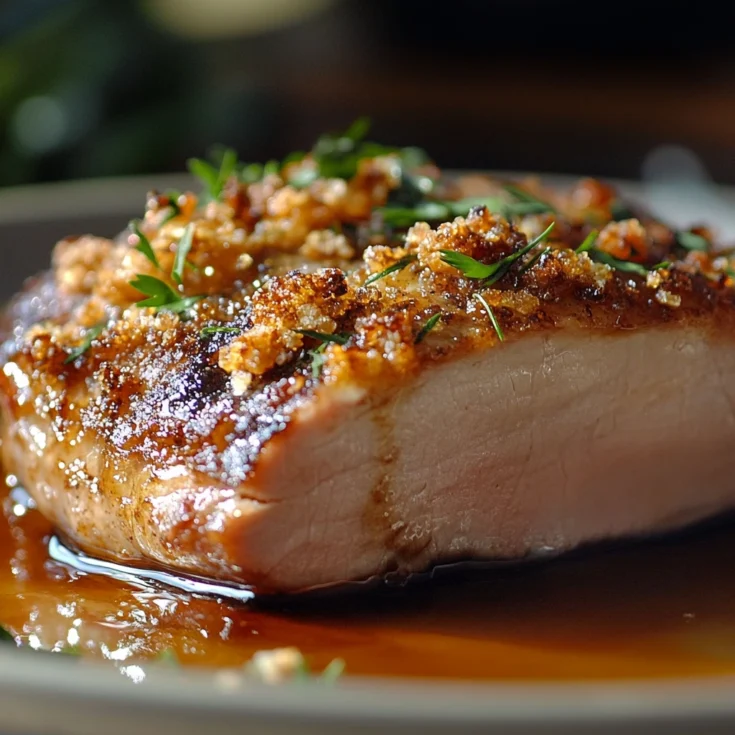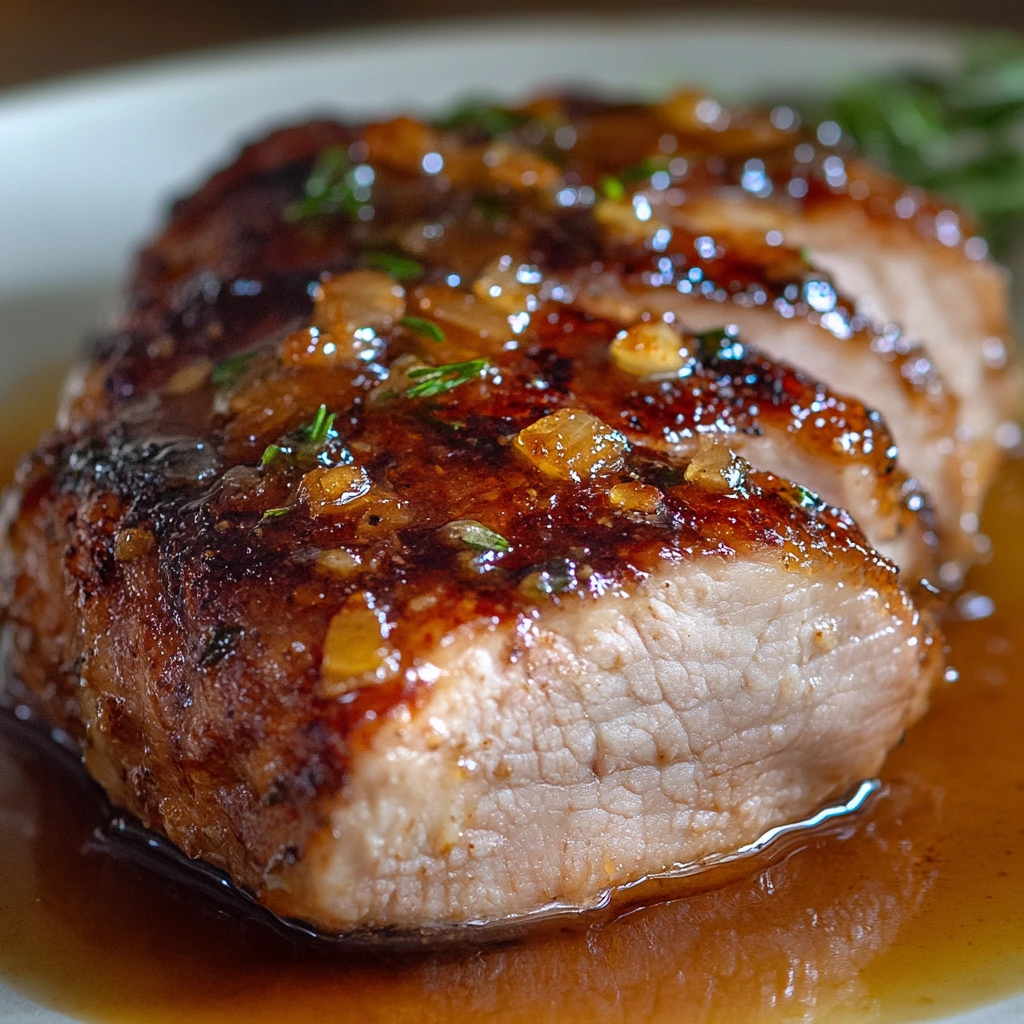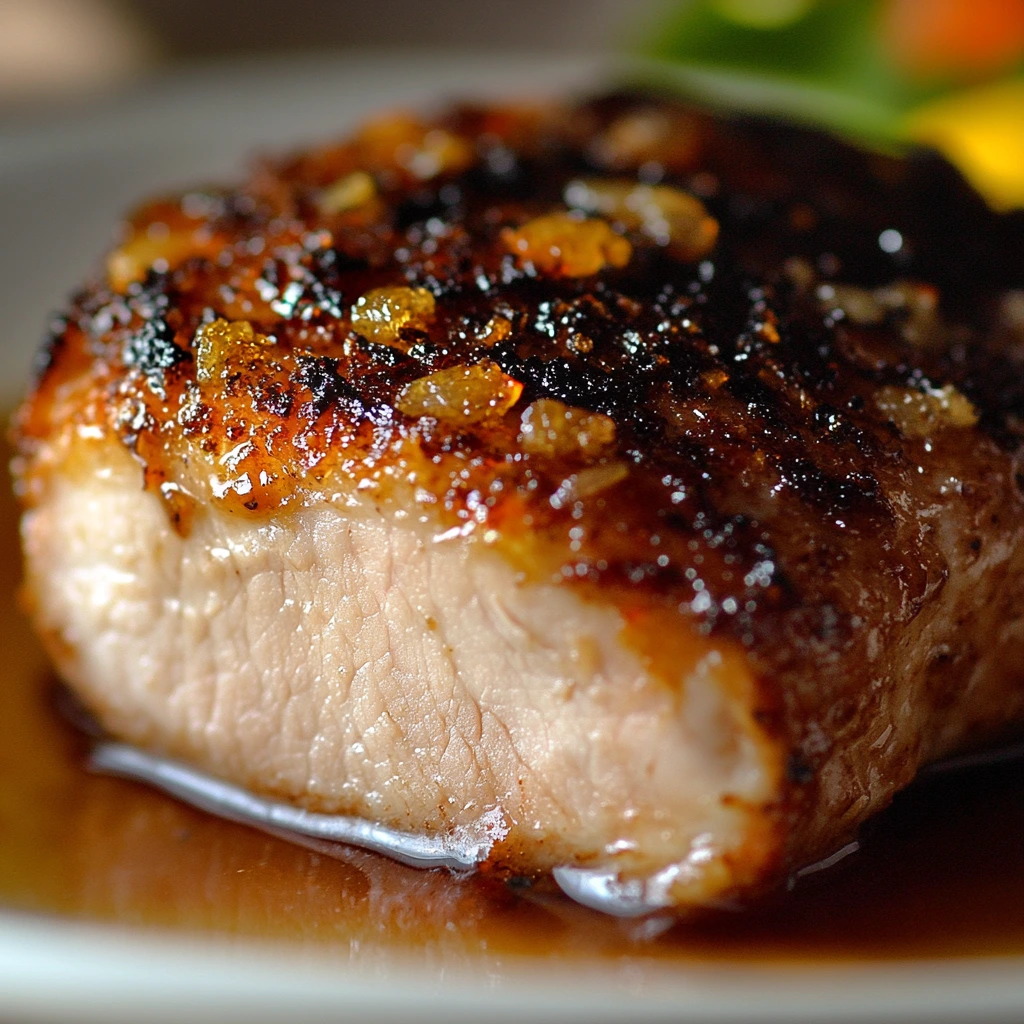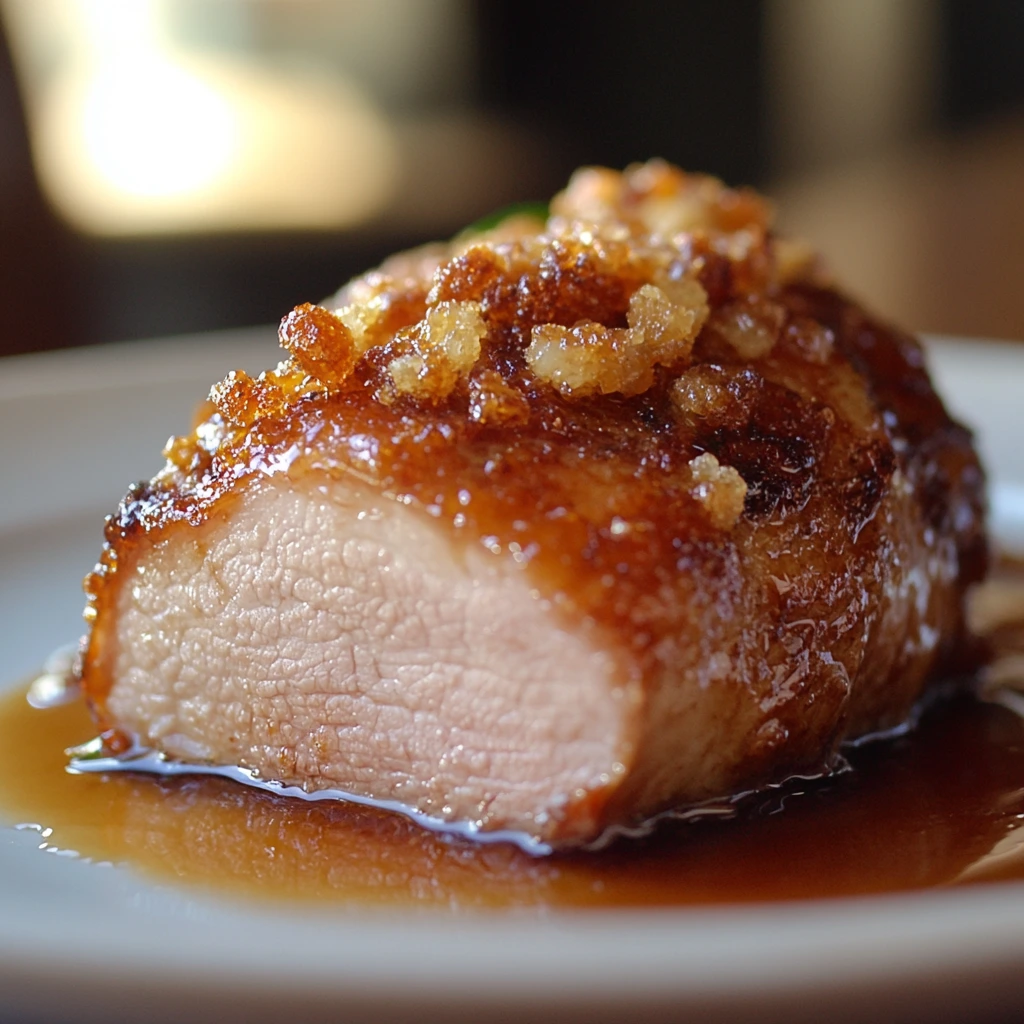Introduction & Culinary Appeal
1.1. Overview of the Dish — What Makes Brown Sugar Crusted Pork Roast Medallions Irresistible
Brown Sugar Crusted Pork Roast Medallions are a flavorful, showstopping dish that instantly elevates any meal. These tender cuts of pork are coated in a golden crust of brown sugar, spices, and seasoning that caramelizes beautifully during cooking. The result is a rich, savory medallion with a crisp, slightly sweet coating that melts in your mouth.
The true magic lies in the contrast—savory pork meets sweet caramelized edges. This balance keeps each bite interesting. It’s a dish that satisfies comfort food cravings while offering gourmet appeal. Whether served on a weeknight table or at a festive gathering, it always impresses.
This recipe has gained popularity in home kitchens due to its simplicity, yet it wouldn’t feel out of place in an upscale bistro. It blends approachable ingredients with elegant results, making it ideal for cooks of all skill levels looking to create something memorable.
1.2. Why This Recipe Stands Out — Sweet Meets Spice in a Perfect Pork Medallion
What sets these pork medallions apart is the crust. A combination of brown sugar, a hint of spice, and a touch of salt creates a flavor that hits all the right notes. The pork stays juicy and tender inside, while the outer crust turns golden and slightly crispy—creating a contrast that’s hard to resist.
This dish is highly adaptable. You can serve it with seasonal vegetables, over mashed potatoes, or with a fresh salad. It fits holiday dinners, Sunday meals, and even quick midweek plans.
Despite its gourmet presentation, it’s quick and easy to prepare. With minimal ingredients and straightforward steps, anyone can make this dish shine—even on a busy schedule.
Ingredients & Preparation Techniques
2.1. Selecting the Right Cut — Pork Loin vs. Tenderloin for Medallions
Choosing the right cut is key to achieving perfect pork roast medallions. While both pork loin and tenderloin come from the same animal, they offer different textures and cooking results.
Pork tenderloin is leaner and more tender. It cooks quickly and stays juicy when sliced into medallions. Its mild flavor makes it ideal for soaking up marinades and spice rubs.
Pork loin, on the other hand, is larger and slightly firmer. Though it can be used, it requires more care to avoid overcooking. For this recipe, tenderloin is the better choice. It ensures soft, evenly cooked medallions that pair well with a sugary crust.
Slicing into medallions allows for quicker cooking and better crust-to-meat ratio. Each piece caramelizes nicely, giving you a flavorful bite every time.
2.2. Crafting the Brown Sugar Crust — Sweet, Spiced, and Full of Texture
The crust is the star of this dish. Brown sugar delivers rich sweetness and caramelization. When combined with spices like cumin, chili powder, and cinnamon, it creates an irresistible depth of flavor.
Cumin brings warmth. Chili powder adds a gentle kick. Cinnamon rounds everything out with a hint of spice. Together, they balance the sugar and enhance the pork’s natural savoriness.
For extra texture, chopped pecans can be mixed into the crust. They toast while cooking, adding crunch and nutty notes. It’s a simple upgrade that makes a big impact.
Want more layers of flavor? Garlic powder, Dijon mustard, or maple syrup can be added to the mix. These extras blend beautifully with the brown sugar, enriching the crust without overpowering it.
2.3. Marination and Seasoning — How to Lock in Bold Flavor
Seasoning matters. While the crust provides flavor, marinating the pork first adds moisture and complexity. You can choose between a dry rub or a wet marinade, depending on your preference and time.
A dry rub blends spices and sugar, sticking directly to the surface. It forms a thick crust and delivers strong flavor.
A wet marinade usually contains oil, vinegar, or citrus juice. It seeps into the meat, enhancing juiciness. For this dish, a simple blend of olive oil, garlic, and a touch of mustard works beautifully.
For best results, marinate for at least 30 minutes. If time allows, let the medallions soak overnight. This deepens the taste and keeps the pork moist during cooking.
No matter the method, let the meat sit at room temperature for 15 minutes before cooking. This helps it cook evenly and stay tender.
2.4. Cooking Methods — Achieving the Perfect Crust and Juicy Center
Proper technique makes all the difference. Start by pan-searing the medallions. This step locks in flavor and creates a caramelized brown sugar crust that’s crisp and golden.
Use a hot, oven-safe skillet and sear each side for 2–3 minutes. Don’t move the pork too much—let the crust form.
After searing, finish in the oven. Roasting ensures the inside cooks evenly without drying out. Bake at 375°F (190°C) for 10–12 minutes, depending on thickness.
To guarantee juicy pork, use a meat thermometer. The safe internal temperature is 145°F (63°C). Once it hits the mark, remove the medallions and let them rest for 5–10 minutes. This seals in juices and keeps every bite tender.
Serving Suggestions & Pairings
3.1. Ideal Side Dishes — Balanced Plates with Color, Texture, and Flavor
Pairing Brown Sugar Crusted Pork Roast Medallions with the right sides completes the meal. The dish is rich and sweet-savory, so sides should balance and contrast those flavors.
Roasted vegetables are a perfect match. Try carrots, sweet potatoes, or Brussels sprouts. Their natural sweetness enhances the brown sugar crust, while their texture adds depth.
Grains provide a hearty base. Wild rice brings a nutty flavor that pairs beautifully with pork. Quinoa adds lightness and protein. Couscous offers a soft, quick-cooking option with a gentle bite.
Fresh salads cut through richness and add brightness. Opt for greens like arugula, spinach, or mixed baby greens. A tangy vinaigrette with lemon, balsamic, or apple cider vinegar helps cleanse the palate between bites.
This combination keeps the plate balanced: protein, fiber, crunch, and flavor—all in harmony.
3.2. Sauce Accompaniments — Sweet, Tangy, and Rich Finishing Touches
A well-chosen sauce enhances each bite of pork without overpowering the crust. You don’t need much, just enough to complement.
Maple glaze or honey mustard sauce brings out the brown sugar’s sweetness while adding tang. These are easy to prepare and pair seamlessly with the existing flavors.
For a more gourmet twist, a sherry-style demi-glace offers depth and richness. This smooth, dark sauce contrasts the pork’s sweetness and adds complexity.
Want something fruitier? Try an apple or pear compote. The subtle fruit notes pair well with pork and add a refreshing bite. It also gives the dish a seasonal flair—perfect for fall and winter dinners.3.3. Beverage Pairings — Sip Smart with Complementary Flavors
Choosing the right drink helps round out the experience.
For a non-alcoholic option, sparkling apple cider is crisp and fruity. It refreshes the palate and enhances the pork’s sweet notes. Herbal teas like mint or chamomile also offer a warm, soothing balance to the dish.
If including alcohol for serving suggestions only: amber ale and brown ale work well. Their malty notes echo the brown sugar crust.
For wine suggestions only if requested, Pinot Noir (light and fruity) or Chardonnay (smooth and buttery) are common pairings. However, this dish shines with or without alcohol on the table.
Tips, Variations & Common Mistakes
4.1. Cooking Tips — Simple Steps for Maximum Flavor and Juiciness
Success in the kitchen comes down to the small things. Here are three easy ways to improve your Brown Sugar Crusted Pork Roast Medallions:
Let the meat rest before slicing. After cooking, cover the medallions loosely with foil and rest them for 5–10 minutes. This keeps the juices inside, making the pork tender and moist.
Use a meat thermometer. This is the best way to avoid overcooking. Aim for an internal temperature of 145°F (63°C). Any higher, and the pork can become dry.
Sear before roasting. Searing locks in juices and builds flavor. It also helps the brown sugar crust caramelize and stick better, giving you that irresistible crispy exterior.
4.2. Recipe Variations — Customizing the Dish to Suit Every Palate
Brown Sugar Crusted Pork Medallions are flexible. You can tweak the recipe to suit dietary needs or spice preferences.
Swap pork for chicken or turkey. These lean proteins also work well with a sweet crust. Use boneless chicken breasts or turkey cutlets sliced into medallions.
Add heat with cayenne or smoked paprika. A pinch of spice cuts the sweetness and adds bold depth. Smoked paprika also brings a touch of barbecue flavor.
Change up the nuts. Pecans are great, but almonds or walnuts bring new texture and flavor. Toast the nuts slightly before adding them to the crust mix for extra crunch.
Feel free to get creative with herbs and spices. Just keep the balance between sweet, savory, and heat in check.
4.3. Common Mistakes to Avoid — Keep the Dish from Falling Flat
Avoiding simple errors makes the difference between good and great:
Don’t overcook. Pork can turn dry and tough quickly. Monitor it closely and pull it from the oven as soon as it hits 145°F (63°C). Let it rest before serving.
Let the crust set properly. Rushing the sear or skipping the oven can make the crust fall apart. Take your time when searing, and avoid flipping the meat too soon.
Too much sugar ruins the balance. While brown sugar is key, overdoing it makes the dish overly sweet. Measure carefully and balance with spices and salt.
Frequently Asked Questions (FAQs)
5.1. Can I prepare this dish ahead of time?
Yes, this recipe is ideal for prepping in advance. You can marinate the pork medallions up to 24 hours before cooking. Prepare the brown sugar crust separately and store it in an airtight container. When ready to cook, simply coat the pork with the crust and follow the cooking instructions. This makes the dish perfect for busy weeknights or entertaining guests.
5.2. What can I use as a substitute for brown sugar?
If you’re out of brown sugar or prefer something different, there are several alternatives. Honey and maple syrup offer a similar sweetness and depth, though they create a wetter crust. Coconut sugar is a great option for a slightly less sweet, caramel-like flavor. Adjust quantities slightly based on the sweetness level of your chosen substitute.
5.3. How do I store and reheat leftovers?
Leftover pork medallions keep well for up to three days in the refrigerator. Store them in an airtight container to maintain flavor and moisture. When reheating, use the oven set at 350°F (175°C) for best results. Heat until warmed through—this helps maintain the crust without drying out the meat. Avoid microwaving if possible, as it can soften the crust.
5.4. Is this recipe suitable for special diets?
This dish can be gluten-free if you ensure all ingredients, especially spices and condiments, are certified gluten-free. However, it is not suitable for vegetarian or vegan diets due to the use of pork. For other dietary needs, it can be adapted slightly—such as reducing sugar or using heart-healthy nuts.
Brown Sugar Crusted Pork Roast Medallion

Brown Sugar Crusted Pork Roast Medallions offer a mouthwatering fusion of sweet and savory, making them an irresistible main dish for any occasion. Each tender pork medallion is encrusted with a caramelized brown sugar coating, laced with warm spices like cumin, cinnamon, and chili powder. The result is a golden-brown crust with subtle heat and a hint of spice, balanced perfectly by the pork’s natural richness.
What sets this recipe apart is its balance—sweet but not sugary, spicy but not overpowering. It’s the kind of dish that transforms a simple pork tenderloin into something gourmet, without requiring hours in the kitchen. The seared crust locks in moisture while delivering bold, aromatic flavors in every bite. Whether you’re preparing a cozy weeknight dinner or hosting guests, this dish always impresses.
Add chopped pecans for a nutty crunch, or pair it with a maple glaze or apple compote for an elegant twist. It’s also easily adaptable—swap pork for chicken or turkey, or turn up the heat with cayenne pepper for a bolder version. Serve it alongside roasted vegetables, wild rice, or a crisp salad for a well-rounded plate.
Another reason to love this recipe? It’s weeknight friendly. With just 15 minutes of prep and 25 minutes to cook, you’ll have a restaurant-quality meal on the table in under an hour. Plus, it's gluten-free when made with the right ingredients, so it's suitable for a variety of dietary needs.
Flavorful, flexible, and fast—Brown Sugar Crusted Pork Roast Medallions are destined to become a go-to favorite.
Ingredients
- 1.5 lbs pork tenderloin, sliced into 1-inch medallions
- 1/2 cup brown sugar
- 1 teaspoon chili powder
- 1/2 teaspoon ground cumin
- 1/4 teaspoon ground cinnamon
- 1/2 teaspoon salt
- 1/4 teaspoon black pepper
- 2 tablespoons olive oil
- Optional: 1/4 cup chopped pecans
Instructions
Notes




